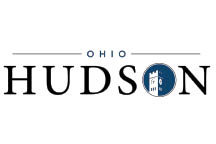$48 million in planned infrastructure projects demonstrate ‘reinvestment’ commitment, Sheridan says
by Judy Stringer
Reinvestment was a major theme of Hudson City Manager Thom Sheridan’s 2023 State of the City address.
Hudson plans to complete 88 infrastructure projects over the next five years – a $48.1 million spend – Sheridan said at the Feb. 23 Hudson Area Chamber of Commerce event. This year alone, $22 million is earmarked for infrastructure improvements.
“We have a $97-million budget,” he explained. “I don’t know too many communities that can say that they’re putting one-fifth of their budget into infrastructure.”
Sheridan told the business audience that rising revenue receipts are helping fuel the ambitious engineering schedule. Income tax revenues were up 10.7% in 2022, and the city ended last year with a 69% carryover balance.
“Our target [carryover balance] is 40%, so we’re 29 points above that,” he said.
Culvert replacements, school zone crosswalk signals, clubhouse renovations at Ellsworth Meadows Golf Course, and new water lines and sidewalks are among the planned projects.
According to Sheridan, the city will spend $4 million in 2023 to complete several parts of its 2020 connectivity plan, including construction of sidewalks along Middleton Road (between the 480 overpass and Valley View intersection) and E. Streetsboro Road (from N. Hayden Parkway to Stow Road).
Hudson is also working with nearby municipalities on two connector trails. It is partnering with the city of Stow to convert local sections of an abandoned rail line into a new multi-purpose trail. That trail is projected to eventually run from Barlow Road, near Ellsworth Meadows Golf Course, to downtown Akron.
In addition, Hudson is collaborating with the village of Boston Heights to link its northwest corner to Summit Metro Park’s Bike and Hike trail via a planned E. Hines Hill Road path.
Sheridan highlighted the addition of smart traffic signals over the next two years as a significant boost to Hudson’s downtown infrastructure. A $2.3-million grant from the state of Ohio will help pay for 16 adaptive traffic signals. The adaptive signals will move traffic as quickly and efficiently as possible, he said, by communicating with one another and mitigating backups.
“This saves us from paving more roads. This saves us from adding more lanes,” Sheridan noted, calling the technology “the best alternative we’ve ever had” for congestion.
“We don’t want to add four lanes through the downtown, and technically we can’t because there’s a clock tower in the way.”
Rethinking and refocusing
Along with reinvestment, Sheridan said he and his staff are rethinking and refocusing operations on several fronts.
For example, in response to challenges finding part-time and seasonal help, the city will rethink hiring and employment practices. Hudson is also considering how it can work with a private business to extend the city-owned Velocity Broadband service to residents. The service is now primarily available to businesses.
Sheridan also noted how the city refocused its economic development efforts to lean more toward retention than recruitment in a climate where fewer companies are building by launching the Hudson Elevates Industry Series.
“Instead of going out and cold calling all the different daycares in town, we decided to have like a breakfast, bring all the daycares in … [and find out] what are their needs, what are their wants, what are their challenges, how can we help them,” he said.
A big part of rethinking and refocusing, Sheridan added, is the 2023 Comprehensive Plan Update, currently underway. A 19-person steering committee will survey residents and host forums to better understand public sentiment on land use and major development issues, including what to do with the vacant Youth Development Center Property on Hines Hill and the slated Phase II property downtown.
“I can’t wait to see what the final results are of that,” he said. “That is the plan that we use as we go and develop for the next decade or so.” ∞

